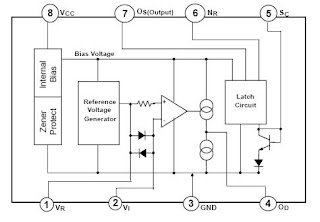EARTH LEAKAGE CURRENT DETECTOR

FUNCTION
The UTC M54123L circuit for the amplifying parts of earth leakage circuit breaker consists of differential amplifier, latch circuit and voltage regulator. It is connected to the secondary side of the zero current transformer (ZCT) which detects leakage current in the both input of the differential amplifier. Signals amplified by differential amplifier are integrated by an external capacitor, and connects to the input terminal of latch circuit with output suitable for the characteristics of high- speed earth leakage circuit breaker. Latch circuit keeps low in the output till the input voltage reaches the fixed level, and output becomes high when the leakage current more than fixed flows.
It drives a thyristor connected to the output terminal of latch circuit.
FEATURES*Suitable for JIS C 8371
*Good temperature characteristics of input sensitivity
current
*High input sensitivity (VT=6.1mV Typ.)
*Low external component count
*High noise and surge-proof
*Low power dissipation (Pd=5mW Typ.) and may be
used both as 100V and 200V.
*Wide temperature range (Ta=-20~+80°C)
Datasheethttp://www.unisonic.com.tw/datasheet/M54123L.pdf
KA2803B
Earth Leakage Detector

DescriptionThe KA2803B is designed for use in earth leakage circuit
interrupters, for stable operation of the AC line in breakers.
The input of the differential amplifier is connected to the
secondary coil of ZCT(Zero Current Transformer). The
amplified output of differential amplifier is integrated at
external capacitor to gain adequate time delay that is
specified in KSC4613. The level comparator generates high
level when earth leakage current is greater than the fixed
level.
Features
• Low Power Consumption PD =5mW, 100V/200V
• Built-in Voltage Regulator
• High Gain Differential Amplifier
• 0.4mA Output Current Pulse to Trigger SCR' S
• Low External Part Count
• DIP Package (8-DIP), High Packing Density
• High Noise Immunity, Large Surge Margin
• Super Temperature Characteristic of Input Sensitivity
• Wide Operating Temperature Range (TA = -25C ~
+80C)
• Operation from 12 to 20V Input
Datasheet
http://www.fairchildsemi.com/ds/KA%2FKA2803B.pdf
RV4141A
Low Power Ground Fault Interrupter

Description
The RV4141A is a low-power controller for AC receptacle
ground fault circuit interrupters. These devices detect
hazardous current paths to ground and ground to neutral
faults. The circuit interrupter then disconnects the load from
the line before a harmful or lethal shock occurs.
Internally, the RV4141A contains a diode rectifier, shunt
regulator, precision sense amplifier, current reference, time
delay circuit, and SCR driver.
Two sense transformers, SCR, solenoid, three resistors and
four capacitors complete the design of the basic circuit interrupter.
The simple layout and minimum component count
ensure ease of application and long term reliability.
Features not found in other GFCI controllers include a low
offset voltage sense amplifier eliminating the need for a
coupling capacitor between the sense transformer and sense
amplifier, and an internal rectifier to eliminate high voltage
rectifying diodes.
The RV4141A is powered only during the positive half
period of the line voltage, but can sense current faults independent
of its phase relative to the line voltage. The gate of
the SCR is driven only during the positive half cycle of the
line voltage.
Features
• Powered from the AC line
• Built-in rectifier
• Direct interface to SCR
• 500 μA quiescent current
• Precision sense amplifier
• Adjustable time delay
• Minimum external components
• Meets UL 943 requirements
• For use with 110V or 220V systems
• Available in an 8-pin SOIC package
Datasheethttp://www.fairchildsemi.com/ds/RV%2FRV4141A.pdf
